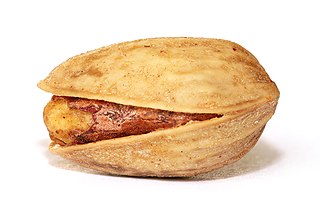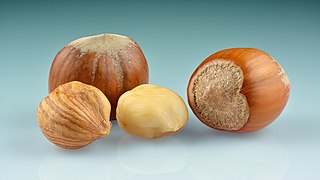| Macadamia tetraphylla | |
|---|---|
 | |
| Foliage and fruits | |
| Scientific classification | |
| Kingdom: | Plantae |
| Clade: | Tracheophytes |
| Clade: | Angiosperms |
| Clade: | Eudicots |
| Order: | Proteales |
| Family: | Proteaceae |
| Genus: | Macadamia |
| Species: | M. tetraphylla |
| Binomial name | |
| Macadamia tetraphylla | |

Macadamia tetraphylla is a tree in the family Proteaceae, native to southern Queensland and northern New South Wales in Australia. Common names include macadamia nut, bauple nut, prickly macadamia, Queensland nut, rough-shelled bush nut and rough-shelled Queensland nut.
Contents
This species has dense foliage and grows up to 18 metres in height. The leaves have toothed margins and are 7 to 25 cm long. As the species name "tetraphylla" implies, it usually has four leaves more or less equally spaced around each leaf node, whereas the other main commercial species "integrifolia" has a variable leaf number but usually three. It has long, pendant white to creamy pink to purple flowers, followed by woody, rounded fruits which are 2 to 3 cm in diameter and contain edible seeds. [2] As one common name implies, the shell of this species is often dimpled or "rough shelled" as compared to the integrifolia, which has a smooth shell, and always white flowers.
It has been introduced to Mexico and has done well in the states of Michoacán and Jalisco and has become an important export crop for the Mexican market. [3] Hawaii is the largest exporter of this crop worldwide. Both species of Macadamia have not done well in the pure tropics, with no fully successful plantations less than 15 degrees from the equator. Major plantations in Costa Rica, at 10 degrees north, are said to produce much less than in Hawaii at 19 to 22 degrees north, in one case 20% the production. Plantations in Guatemala at 15 degrees north are successful. However, individual seedling trees have produced well in the pure tropics and need to be selected. One grower noted that the integrifolia flowers in Costa Rica have no aroma, leading to low and erratic pollination. Macadamia tetraphylla has a higher sugar content than integrifolia, leading to problems of burning when baked in cookies and other desserts, thus most commercial macadamias are of the integrifolia species to assure conformity of roasting and baking results. Many tetraphylla or hybrids of tetraphylla and integrifolia are grown in home orchards. The higher sugar content of tetraphylla is preferred by some, especially for eating raw.This species has dense foliage and grows up to 18 metres in height. The leaves, which have toothed margins, are 7 to 25 cm in length. As the species name "tetraphylla" implies, it usually has four leaves more or less equally spaced around each leaf node, whereas the other main commercial species "integrifolia" has a variable leaf number but usually three. It has long, pendant white to creamy pink to purple flowers, followed by woody, rounded fruits which are 2 to 3 cm in diameter and contain edible seeds. [2] As one common name implies, the shell of this species is often dimpled or "rough shelled" as compared to the integrifolia, which has a smooth shell, and always white flowers.
It has been introduced to Mexico and has done well in the states of Michoacán and Jalisco and has become an important export crop for the Mexican market. [3] Hawaii is the largest exporter of this crop worldwide. Both species of Macadamia have not done well in the pure tropics, with no fully successful plantations less than 15 degrees from the equator. Major plantations in Costa Rica, at 10 degrees north, are said to produce much less than in Hawaii at 19 to 22 degrees north, in one case 20% the production. Plantations in Guatemala at 15 degrees north are successful. However, individual seedling trees have produced well in the pure tropics and need to be selected. One grower noted that the integrifolia flowers in Costa Rica have no aroma, leading to low and erratic pollination. Macadamia tetraphylla has a higher sugar content than integrifolia, leading to problems of burning when baked in cookies and other desserts, thus most commercial macadamias are of the integrifolia species to assure conformity of roasting and baking results. Many tetraphylla or hybrids of tetraphylla and integrifolia are grown in home orchards. The higher sugar content of tetraphylla is preferred by some, especially for eating raw.



















